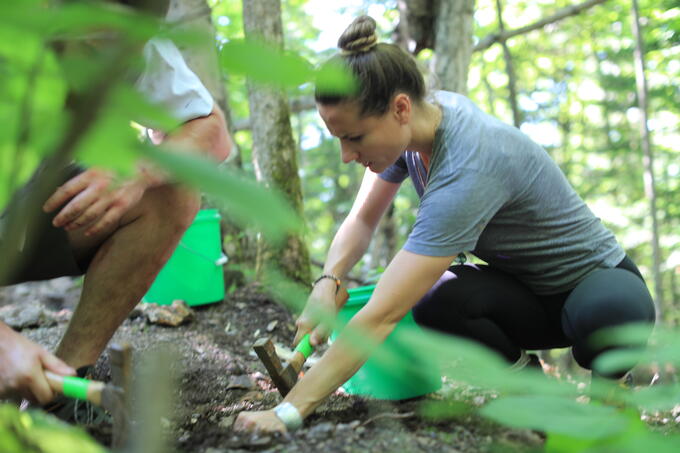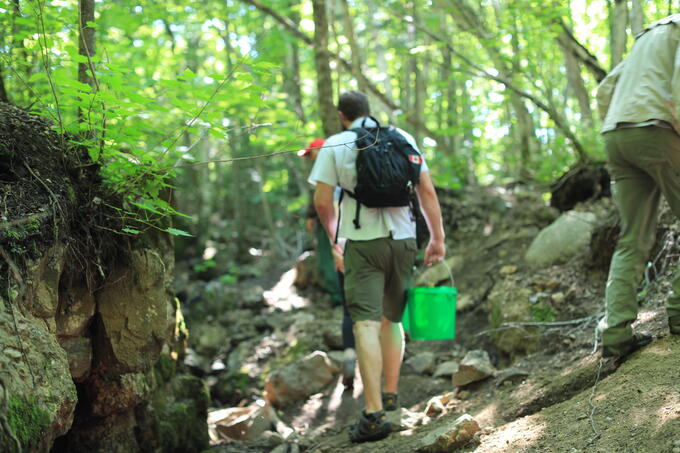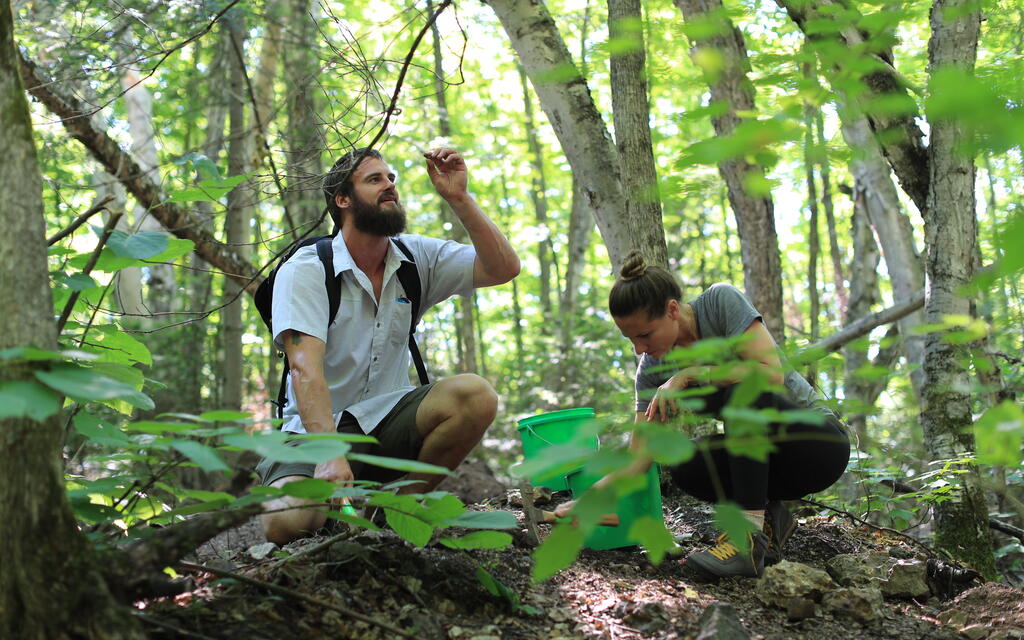If you can’t pass an interesting looking rock without stopping to take a closer look, you may be a rockhound in waiting. There’s no doubt rockhounds are a special breed: their faces light up and their eyes shine when they talk about their hunt for cool rocks and minerals, either reminiscing about past finds or dreams for the next adventure.
Ontario’s Highlands is a rockhound’s dream destination – our abundance of Canadian Shield, hilly terrain and rocky topography make for some interesting geological settings. As home to the Mineral Capital of Canada in Hastings County, geology is a big deal across the entire region.
If you’ve ever wondered if you are an undiscovered rockhound, read on.

Want to learn more about rockhounding in Ontario's Highlands? Read our geology brochure that has all the details or where to go and what to do.
Why Become a Rockhound?
Everyone you talk to who is into rockhounding is really into it. So it must be good, right? The truth is that rockhounding has lots of appeal. It gets you outdoors, it’s fun to do with a friend or partner, but you can also do it alone.
It can be done anywhere or you can drive to places known for their unusual geology. Even more important, anyone can be a rockhound; there is no experience necessary and it’s pretty much free! From an environmental perspective, rockhounding is an important reminder of the vastness of the Earth and the millions of years of physical change that led us to the world we see today.
Deep beneath the Earth’s surface lies mysteries that tell stories of geological pressures and shifting of the earth’s crust to develop craggy mountains, the glaciers that created the Canadian Shield, and other agents of geological change that have affected our landscapes and every living thing that thrives here.
How to Rockhound
First of all, rockhounding is the perfect experience for families – even little ones will love the chance to get close to the earth and dig for treasure. Before you set off on your first rockhounding adventure, make sure you are outfitted for success. This means you will want to have the following with you:
- Water
- Outdoor clothing (remember to protect against ticks!)
- Snacks
- Insect repellant
- Small shovel or trowel
- Rock hammer or chisel
- A few buckets
- Safety goggles
- Compass
- Topography map of the area
- Notebook and pencil or pen

Pick a location that allows for public access and is known for its unique finds, then cop a squat and do a little digging. As you find unique rocks and minerals, snap a picture or set them aside for identification. If your location allows you to remove rocks (please be respectful of local rules) then you can take yours home and add to your collection!
Where to Try Rockhounding
Ontario’s Highlands is the perfect place to search for unusual rocks – our unique geology is a mix of Canadian Shield and low, undulating valleys that present ideal conditions for unique rock formations.
Be aware that rural properties are privately owned and trespassing is discouraged. Instead, look to road cuts where the rock has been blasted to make way for a highway or through road. You might be surprised by the finds that are just lying around, feet from pavement.

Be careful of loose rocks that make footing hazardous. Be aware of your surroundings and ensure you are not trespassing on private property.
As it happens, Hastings County is the Mineral Capital of Canada and there is a wealth of rockhounding opportunities here.
The area in and around Bancroft in Hastings County is part of the Canadian Shield and has a topography that’s between 1 and 1.8 billion years old. Mining was popular here in the late 1800s and the area has become a rockhounding destination for visitors to Ontario’s Highlands keen to try their hand at it.
You can find a full list of rocks and mineral collection sites in the Bancroft area on the Town of Bancroft website including a CN rock dump, Beryl Pit, and a good road cut.
Some other highlights and experiences in the area include:
Miner’s Loop
This self-guided tour is a chance to walk in the shoes of miners from way back, and will give you a deeper understanding of the history of mining and its impact on the communities that formed around it.
Princess Sodalite Mine Rock Shop and Farm
Open daily May to Thanksgiving, this rock shop is where you can head to learn more about rocks, do some shopping, and pick through the rock farm. If you’re wondering what a rock farm is, it’s an outdoor area that’s seeded by the owners with between 75 and 100 different varieties for rocks, minerals and fossils.
Lakeside Gems
When you’re in the Bancroft area, this is a must visit. These folks will get you outfitted with the tools you need to become a real rockhound! You can also book a geologist-led mineral collecting field trip (when available) to learn more about how to collect, the tools you need, and all about identifying minerals.
Greenmantle Farm Mineral Eco-Tours
This 300-acre property is home to the rare mineral fluororicherite, along with other interesting minerals. You can take an eco-tour of the property through Greenmantle Tours, and learn more about rock formations and the minerals that are found there.
Rockhounding Tours with Yours Outdoors
This experience is a bit of a drive from Bancroft in Haliburton County, a region that’s peppered with geological formations and mineral deposits. This half-day or full-day outdoor experience collecting with a local collector to hunt for your own rock finds.
Rockhound Gemboree
Plan to be in Bancroft in August for the annual Rockhound Gemboree, Canada’s largest gem and mineral show. This is a must for anyone getting serious about rockhounding.
These places should give you a good foundation to get started, then you can broaden your horizons and hunt for unique geological finds farther afield. Learn more about rockhounding in Ontario's Highlands here.
Rockhounding in Highlands East
Highlands East has purchased mineral rites to two popular dig sites, Schickler and Desmont. Permission to collect there may be obtained free of charge by completing on online waiver on the municipal website. Please plan ahead and allow three days notice to ensure the processing of your form. A third site, Gibson Road (also know as Titanite Hill) does not require permission. More information is available here.




